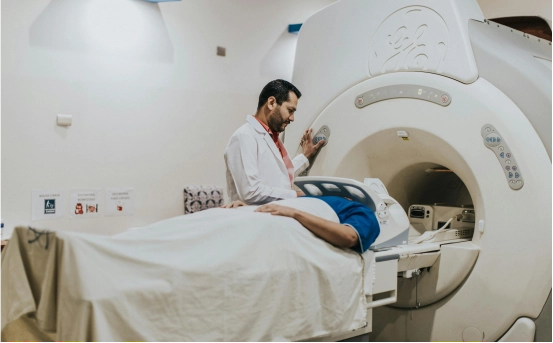Vagus nerve stimulation, often referred to as the “wandering nerve” due to its extensive reach throughout the body, plays a vital role in regulating core bodily functions such as heart rate, digestion, mood, and immune response. Given its powerful influence, researchers have developed methods to stimulate this nerve electrically offering new hope for people with epilepsy, treatment resistant depression, inflammatory disorders, and even migraines.
The vagus nerve, one of the most important nerves in the human body, is at the center of an innovative medical therapy called Vagus Nerve Stimulation (VNS). This therapeutic technique is gaining popularity for treating various conditions, from epilepsy and depression to chronic inflammation and even obesity.
What Is Vagus Nerve Stimulation?
Vagus Nerve Stimulation (VNS) is a medical treatment that uses electrical impulses to stimulate the vagus nerve. This nerve extends from the brainstem to the abdomen, influencing numerous bodily functions including heart rate, digestion, and mood regulation.
VNS typically involves implanting a small device under the skin in the chest. This device sends regular electrical pulses through a wire to the vagus nerve in the neck. These signals modulate brain activity and influence neurotransmitter production, which can help regulate various physiological and neurological processes.
How Does the Vagus Nerve Work?
The vagus nerve is the longest cranial nerve in the body. It plays a crucial role in the parasympathetic nervous system, also known as the “rest and digest” system. It controls essential functions such as heart rate, digestion, mood, immune response, and even speech.
When stimulated, the vagus nerve can send calming signals to the brain and body, potentially reducing inflammation and helping to regulate abnormal brain activity. This forms the basis of VNS therapy.
Medical Conditions Treated with VNS
VNS was originally approved for treating epilepsy and treatment-resistant depression, but ongoing research has expanded its potential benefits. Below are some of the key medical conditions that may benefit from vagus nerve stimulation:
- Epilepsy :- VNS is most widely used for people with drug-resistant epilepsy who do not respond well to anti-epileptic medications. The stimulation helps reduce the frequency and severity of seizures, and in some cases, may even help patients achieve better seizure control over time.
- Depression :- For individuals who do not respond to traditional antidepressants or psychotherapy, VNS has shown promise as an adjunct treatment for major depressive disorder. While not an immediate solution, it may improve symptoms gradually over months.
- Inflammatory Conditions :- VNS has also been studied for chronic inflammatory diseases such as rheumatoid arthritis and Crohn’s disease. It may help regulate the immune response by suppressing inflammatory cytokines.
- Migraines and Cluster Headaches :- Recent studies suggest VNS may provide relief for chronic migraines and cluster headaches, particularly through non-invasive methods using external stimulators.
- Obesity and Metabolic Disorders :- Emerging evidence indicates that VNS could potentially help with weight management and metabolic regulation by influencing the gut-brain axis and controlling appetite signals.
Types of Vagus Nerve Stimulation
There are two main types of VNS :-
- Invasive VNS :- This involves a surgical procedure to implant a pulse generator under the skin in the chest. A wire is threaded under the skin and connected to the vagus nerve in the neck. The device sends intermittent electrical pulses to the nerve. Patients usually have a handheld magnet to temporarily activate or deactivate the device.
- Non Invasive VNS (nVNS) :- Also known as transcutaneous vagus nerve stimulation (tVNS), this method does not require surgery. Instead, it uses external devices applied to the ear or neck to stimulate the vagus nerve. While less powerful than implanted versions, it offers a safer and more convenient option, especially for headache or pain disorders.
The VNS Implantation Procedure
Implanting a VNS device is a relatively minor surgical procedure. Here’s what typically happens :-
-
The patient is placed under general anesthesia.
-
A small incision is made in the upper chest to place the pulse generator.
-
Another small incision is made in the neck to expose the vagus nerve.
-
The wire is then wrapped around the nerve and connected to the device.
-
Once implanted, the device is programmed using a computer to deliver pulses at specific intervals.
The entire procedure usually takes 1 to 2 hours, and most patients can go home the same day or the next.
Recovery and Follow Up
Recovery from VNS surgery is usually quick, with most patients resuming normal activities within a few days. The device does not deliver continuous stimulation; rather, it sends signals in regular cycles, which can be adjusted during follow-up visits.
Most patients report mild side effects initially, which tend to decrease over time as the body adapts. Regular check-ups are necessary to monitor the device, make adjustments, and assess the treatment response.
Potential Risks and Side Effects of VNS
As with any medical treatment, VNS comes with certain risks and potential side effects. Common ones include :-
-
Hoarseness or voice changes
-
Throat pain
-
Coughing
-
Difficulty swallowing
-
Tingling sensations
-
Neck pain
These effects are usually mild and occur during stimulation. In rare cases, patients may experience infection at the implant site, breathing difficulties, or heart rhythm abnormalities.
Advantages of VNS Therapy
Despite the risks, many patients find VNS beneficial, especially when traditional treatments fail. Its key advantages include :-
-
Reduction in seizure frequency in epilepsy
-
Long term improvement in depressive symptoms
-
Non drug based option with fewer systemic side effects
-
Potential to modulate inflammation and improve immune function
The Future of Vagus Nerve Stimulation
The future of VNS is promising. Research is currently exploring its use in treating Alzheimer’s disease, anxiety disorders, post traumatic stress disorder (PTSD), and even long COVID symptoms. As technology advances, we can expect more refined devices, improved targeting, and greater patient accessibility through wearable options.
Moreover, personalized stimulation protocols using AI driven feedback systems may revolutionize how VNS is delivered and monitored in real time.
Conclusion
Vagus Nerve Stimulation is an exciting advancement in the world of neuromodulation. While it’s not a one size fits all solution, it offers hope to individuals with chronic and treatment resistant conditions. Whether you’re considering VNS for epilepsy, depression, or another medical issue, it’s essential to consult a specialist who can evaluate your suitability for the therapy.























